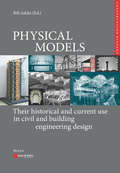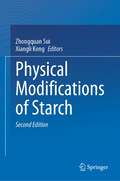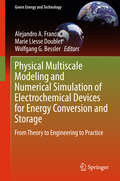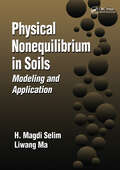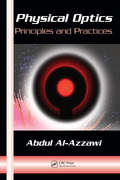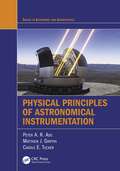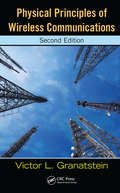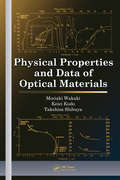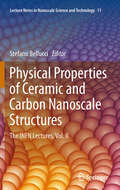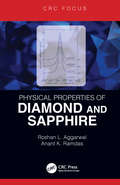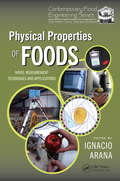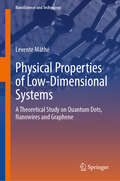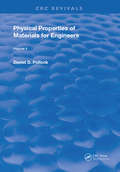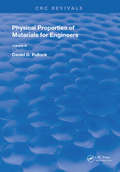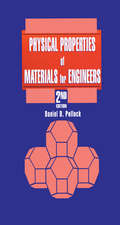- Table View
- List View
Physical Models of Semiconductor Quantum Devices
by Ying FuThe science and technology relating to nanostructures continues to receive significant attention for its applications to various fields including microelectronics, nanophotonics, and biotechnology. This book describes the basic quantum mechanical principles underlining this fast developing field. From the fundamental principles of quantum mechanics to nanomaterial properties, from device physics to research and development of new systems, this title is aimed at undergraduates, graduates, postgraduates, and researchers.
Physical Models: Their historical and current use in civil and building engineering design (Edition Bautechnikgeschichte / Construction History)
by Bill Addis Karl-Eugen Kurrer Werner LorenzPhysical models have been, and continue to be used by engineers when faced with unprecedented challenges, when engineering science has been non-existent or inadequate, and in any other situation when the engineer has needed to raise their confidence in a design proposal to a sufficient level to begin construction. For this reason, models have mostly been used by designers and constructors of highly innovative projects, when previous experience has not been available. The book covers the history of using of physical models in the design and development of civil and building engineering projects including bridges in the mid-18th century, William Fairbairn?s Britannia bridge in the 1840s, the masonry Aswan Dam in the 1890s, concrete dams in the 1920s, thin concrete shell roofs and the dynamic behaviour of tall buildings in earthquakes from the 1930s, tidal flow in estuaries and the acoustics of concert halls from the 1950s, and cable-net and membrane structures in the 1960s. Traditionally, progress in engineering has been attributed to the creation and use of engineering science, the understanding materials properties and the development of new construction methods. The book argues that the use of reduced scale models have played an equally important part in the development of civil and building engineering. However, like the history of engineering design itself, this crucial contribution has not been widely reported or celebrated. The book concludes with reviews of the current use of physical models alongside computer models, for example, in boundary layer wind tunnels, room acoustics, seismic engineering, hydrology, and air flow in buildings.
Physical Modifications of Starch
by Zhongquan Sui Xiangli KongThis book provides comprehensive information on starch modification using physical approaches – a field that has attracted increasing interest in recent years due to the fact that it is no longer desirable to label starch a modified. The required functionalities can be conveniently achieved by physical methods that are less expensive and more environmentally friendly. Intended for researchers and product developers working on starch, the book summarizes recent developments in the areas of starch physical modifications and reviews the structure, function and potential industrial applications of modified starch. Dr. Zhongquan Sui is an Associate Professor at Shanghai Jiao Tong University. Dr. Xiangli Kong is an Assistant Professor at Zhejiang University.
Physical Modifications of Starch
by Zhongquan Sui Xiangli KongThis book provides comprehensive information on starch modification using physical approaches – a field that has attracted increasing interest in recent years due to the fact that it is no longer desirable to label starch a modified. The required functionalities can be conveniently achieved by physical methods that are less expensive and more environmentally friendly. In the second edition, chapters are updated according to the recent research progress. Three new chapters are added including pulsed electric fields, dry heating and physical treatments that produce chemical changes. Chapter one is rewrote into three individual chapters including Molecular Structure of Starch, Granular Structure of Starch and Physicochemical Properties of Starch, aiming to help the readers better understand the structure of starch. This book summarizes recent developments in the areas of starch physical modifications and reviews the structure, function and potential industrial applications of modified starch. It provides valuable information for researchers and product developers to work on starch.
Physical Multiscale Modeling and Numerical Simulation of Electrochemical Devices for Energy Conversion and Storage
by Alejandro A. Franco Marie Liesse Doublet Wolfgang G. BesslerThe aim of this book is to review innovative physical multiscale modeling methods which numerically simulate the structure and properties of electrochemical devices for energy storage and conversion. Written by world-class experts in the field, it revisits concepts, methodologies and approaches connecting ab initio with micro-, meso- and macro-scale modeling of components and cells. It also discusses the major scientific challenges of this field, such as that of lithium-ion batteries. This book demonstrates how fuel cells and batteries can be brought together to take advantage of well-established multi-scale physical modeling methodologies to advance research in this area. This book also highlights promising capabilities of such approaches for inexpensive virtual experimentation. In recent years, electrochemical systems such as polymer electrolyte membrane fuel cells, solid oxide fuel cells, water electrolyzers, lithium-ion batteries and supercapacitors have attracted much attention due to their potential for clean energy conversion and as storage devices. This has resulted in tremendous technological progress, such as the development of new electrolytes and new engineering designs of electrode structures. However, these technologies do not yet possess all the necessary characteristics, especially in terms of cost and durability, to compete within the most attractive markets. Physical multiscale modeling approaches bridge the gap between materials' atomistic and structural properties and the macroscopic behavior of a device. They play a crucial role in optimizing the materials and operation in real-life conditions, thereby enabling enhanced cell performance and durability at a reduced cost. This book provides a valuable resource for researchers, engineers and students interested in physical modelling, numerical simulation, electrochemistry and theoretical chemistry.
Physical Nonequilibrium in Soils: Modeling and Application
by H. Magdi Selim Liwang MaPhysical Nonequilibrium in Soils provides cutting-edge knowledge on physical nonequilibrium phenomena in soils, offering unique insight into the complexity of our physical world. With 18 chapters comprising the book, topics cover soil properties fluid properties mechanistic models transfer function geostatistics fractal analysis cellular-automation fluids coupling of physical and chemical nonequilibrium models confirming and quantifying physical nonequilibrium in soils analytical solutions field-scale research environmental impacts.
Physical Oceanography: A Mathematical Introduction with MATLAB (Advances in Applied Mathematics)
by Reza Malek-MadaniAccessible to advanced undergraduate students, Physical Oceanography: A Mathematical Introduction with MATLAB demonstrates how to use the basic tenets of multivariate calculus to derive the governing equations of fluid dynamics in a rotating frame. It also explains how to use linear algebra and partial differential equations (PDEs) to solve basic i
Physical Optics: Principles and Practices
by Abdul Al-AzzawiSince the invention of the laser, our fascination with the photon has led to one of the most dynamic and rapidly growing fields of technology. As the reality of all-optical systems comes into focus, it is more important than ever to stay current with the latest advances in the optics and components that enable photonics technology. Comprising chapters drawn from the author's highly anticipated book Photonics: Principles and Practices, Physical Optics: Principles and Practices offers a detailed and focused treatment for anyone in need of authoritative information on this critical area underlying photonics.Using a consistent approach, the author leads you step-by-step through each topic. Each skillfully crafted chapter first explores the theoretical concepts of each topic, and then demonstrates how these principles apply to real-world applications by guiding you through experimental cases illuminated with numerous illustrations. The book works systematically through the principles of waves, diffraction, interference, diffraction gratings, interferometers, spectrometers, and several aspects of laser technology to build a thorough understanding of how to study and manipulate the behavior of light for various applications. In addition, it includes a four-page insert containing several full-color illustrations as well as a chapter on laboratory safety.Containing several topics presented for the first time in book form, Physical Optics: Principles and Practices is simply the most modern, detailed, and hands-on text in the field.
Physical Principles of Astronomical Instrumentation (Series in Astronomy and Astrophysics)
by Peter A. Ade Matthew J. Griffin Carole E. TuckerOffering practical advice on a range of wavelengths, this highly accessible and self-contained book presents a broad overview of astronomical instrumentation, techniques, and tools. Drawing on the notes and lessons of the authors’ established graduate course, the text reviews basic concepts in astrophysics, spectroscopy, and signal analysis. It includes illustrative problems and case studies and aims to provide readers with a toolbox for observational capabilities across the electromagnetic spectrum and the knowledge to understand which tools are best suited to different observations. It is an ideal guide for undergraduates and graduates studying astronomy. Features: Presents a self-contained account of a highly complex subject. Offers practical advice and instruction on a wide range of wavelengths and tools. Includes case studies and problems for further learning opportunities.
Physical Principles of Food Preservation: Revised and Expanded
by Marcus Karel Daryl LundThis reference examines the properties, conditions, and theoretical principles governing the safety and efficacy of various food preservation, storage, and packaging techniques. The book analyzes methods to predict and optimize the nutrition, texture, and quality of food compounds while reducing operating cost and waste. The Second Edition contains new chapters and discussions on non-thermal processes; the mechanisms of heat transfer, including conduction, convection, radiation, and dielectric and microwave heating; the kinetic parameters of food process operations; freezing technology, using illustrative examples; recent breakthroughs in cryochemistry and cryobiology, and more.
Physical Principles of Remote Sensing
by W. G. ReesFully updated and containing significant new material on photography, laser profiling and image processing, the third edition of this popular textbook covers a broad range of remote sensing applications and techniques across the Earth, environmental and planetary sciences. It focuses on physical principles, giving students a deeper understanding of remote sensing systems and their possibilities, while remaining accessible to those with less mathematical training by providing a step-by-step approach to quantitative topics. Boxed examples, additional photos and numerous colour images engage students and show them how the theory relates to the many real-world applications. Chapter summaries, review questions and additional problems allow students to check their understanding of key concepts and practise handling real data for themselves. Supplementary online material includes links to freely available software, animations, computer programs, colour images and other web-based resources of interest.
Physical Principles of Wireless Communications
by Victor L. GranatsteinUpdated and expanded, Physical Principles of Wireless Communications, Second Edition illustrates the relationship between scientific discoveries and their application to the invention and engineering of wireless communication systems. The second edition of this popular textbook starts with a review of the relevant physical laws, including
Physical Processes in Inorganic Scintillators (Laser And Optical Science And Technology Ser. #14)
by Piotr A. RodnyiDuring the last ten to fifteen years, researchers have made considerable progress in the study of inorganic scintillators. New scintillation materials have been investigated, novel scintillation mechanisms have been discovered, and additional scintillator applications have appeared. Demand continues for new and improved scintillation materials for a variety of applications including nuclear and high energy physics, astrophysics, medical imaging, geophysical exploration, radiation detection, and many other fields. However, until now there have been no books available that address in detail the complex scintillation processes associated with these new developments.Now, a world leader in the theory and applications of scintillation processes integrates the latest scientific advances of scintillation into a new work, Physical Processes in Inorganic Scintillators. Written by distinguished researcher Piotr Rodnyi, this volume explores this challenging subject, explains the complexities of scintillation from a modern point of view, and illuminates the way to the development of better scintillation materials.This unique work first defines the fundamental physical processes underlying scintillation and governing the primary scintillation characteristics of light output, decay time, emission spectrum, and radiation hardness. The book then discusses the complicated mechanisms of energy conversion and transformation in inorganic scintillators. The section on the role of defects in energy transfer and scintillation efficiency will be of special interest. Throughout, the author does not offer complicated derivations of equations but, instead, presents useful equations with practical results.
Physical Properties and Behaviour of High-Performance Concrete at High Temperature: State-of-the-Art Report of the RILEM Technical Committee 227-HPB (RILEM State-of-the-Art Reports #29)
by Pierre Pimienta Robert Jansson McNamee Jean-Christophe MindeguiaThis book presents the work done by the RILEM Technical Committee 227-HPB (Physical properties and behaviour of High-Performance Concrete at high temperature). It contains the latest research results on the behaviour of high-performance concretes at high temperature. The book presents the state of the art of experimental data on High-Performance concretes and it collects and synthesizes useful data about concrete behaviour at high temperatures. The book is divided into independent chapters dealing with degradation reactions in concrete exposed to high temperatures; mass transport properties; thermal properties; and mechanical properties. The results presented especially target a group of users composed by universities and testing laboratories, building material companies and industries, material scientists and experts, building and infrastructure authorities, designers and civil engineers.
Physical Properties and Data of Optical Materials
by Moriaki Wakaki Takehisa Shibuya Keiei KudoResearch and applications in optical engineering require careful selection of materials. With such a large and varied array to choose from, it is important to understand a material's physical and optical properties before making a selection. Providing a convenient, concise, and logically organized collection of information, Physical Properties and Data of Optical Materials builds a thorough background for more than 100 optical materials and offers quick access to precise information. Surveying the most important and widely used optical materials, this handy reference includes data on a wide variety of metals, semiconductors, dielectrics, polymers, and other commonly used optical materials. For each material, the editors examine the crystal system; natural and artificial growth and production methods along with corrosives and processing; thermal, electrical, and mechanical properties; optical properties, such as transmittance and reflectance spectra, ranging from UV to IR wavelengths; and, where applicable, applications for spectroscopy and miscellaneous remarks such as handling concerns and chemical properties. Numerous tables illustrate important data such as numerical values of optical constants for important wavelength regions, extinction and absorption coefficients, and refractive index. Physical Properties and Data of Optical Materials offers a collection of data on an unprecedented variety of fundamental optical materials, making it the one quick-lookup guide that every optical scientist, engineer, and student should own.
Physical Properties of Ceramic and Carbon Nanoscale Structures
by Stefano BellucciThis is the second volume in a series of books on selected topics in Nanoscale Science and Technology based on lectures given at the well-known INFN schools of the same name. The aim of this collection is to provide a reference corpus of suitable, introductory material to relevant subfields, as they mature over time, by gathering the significantly expanded and edited versions of tutorial lectures, given over the years by internationally known experts. The present set of notes stems in particular from the participation and dedication of prestigious lecturers, such as Andrzej Huczko, Nicola Pugno, Alexander Malesevic, Pasquale Onorato and Stefano Bellucci. All lectures were subsequently carefully edited and reworked, taking into account the extensive follow-up discussions. A tutorial lecture by Huczko et al. shows how a variety of carbon and ceramic nanostructures (nanotubes, nanowires, nanofibres, nanorods, and nanoencapsulates) have in particular great potential for improving our understanding of the fundamental concepts of the roles of both dimensionality and size on physical material properties . Bellucci and Onorato provide an extensive and tutorial review of the (quantum) transport properties in carbon nanotubes, encompassing a description of the electronic structure from graphene to single-wall nanotubes, as well as a discussion of experimental evidence of superconductivity in carbon nanotubes and the corresponding theoretical interpretation. In the first contribution by Pugno, new ideas on how to design futuristic self-cleaning, super-adhesive and releasable hierarchical smart materials are presented. He also reviews the mechanical strength of such nanotubes and megacables, with an eye to the visionary project of a carbon nanotube-based 'space elevator megacable'. In his second contribution, Pugno outlines in detail the role on the fracture strength of thermodynamically unavoidable atomistic defects with different size and shape, both numerically and theoretically, for nanotubes and nanotube bundles. Focusing on graphitic allotropes, the chapter by Bellucci and Malesevic aims to give a taste of the widespread implications carbon nanostructures have on research and applications, starting from an historical overview, followed by a discussion of the structure and physical properties of carbon nanotubes and graphene, in particular in the context of the several different synthesis techniques presently available.
Physical Properties of Concrete and Concrete Constituents
by Jean-Pierre Ollivier Myriam Carcasses Jean-Michel ToorentiUnderstanding the rheological properties of fresh concrete, the hydration phenomenon of cement responsible for structuration, the relationship between the characteristics of the porous solid obtained and its mechanical performances or resistance to the aggressive penetration requires a complex knowledge of the physicochemistry of reactive porous materials. The development of simple formulation rules therefore requires the assimilation of this knowledge and a good command of the properties of these materials.The purpose of this book is to provide the mix designer with useful knowledge on granular materials and porous materials, which will enable the innovative design of concrete. Topics covered include the characterization of granular materials, the concepts of porosity and specific surface area, and the transport properties (diffusion and permeation) of concrete. Some of these topics are already covered in other general books dedicated to granular or porous materials. The objective here is to bring them together in one book by adapting them for use by concrete specialists.Applications in the form of exercises are offered at the end of each chapter to enable readers to assimilate the theoretical knowledge and to apply such knowledge to concrete problems encountered in civil engineering. Contents 1. Description of Granular Materials, Definitions.2. Granulometry.3. Specific Surface Area of Materials.4. Voids in Granular Materials and the Arrangement of Grains.5. Voids in Concrete.6. The Fundamentals of Diffusion.7. Permeability.
Physical Properties of Diamond and Sapphire
by Roshan L. Aggarwal Anant K. RamdasFocusing on the physical properties of diamond and sapphire, this monograph provides readers with essential details on crystal structure and growth, mechanical properties, thermal properties, optical properties, light scattering of diamond and sapphire crystals, and sapphire lasers. Various physical properties are comprehensively discussed: Mechanical properties include hardness, tensile strength, compressive strength, and Young’s modulus. Thermal properties include thermal expansion, specific heat, and thermal conductivity. Optical properties of diamond and sapphire include transmission, refractive index, and absorption. Light scattering includes Raman scattering and Brillouin scattering. Sapphire lasers include chromium-doped and titanium-doped lasers. Aimed at researchers and industry professionals working in materials science, physics, electrical engineering, and related fields, this monograph is the first to concentrate solely on physical properties of these increasingly important materials.
Physical Properties of Foods: Novel Measurement Techniques and Applications (Contemporary Food Engineering)
by Ignacio AranaWith higher food quality in increasing demand by consumers, there is continuous pressure on food engineers to meet market needs. One of the critical challenges is to use modern technology and knowledge to develop new processes for improving food quality. Given the global food marketplace, there is also a greater need for a means of objectively clas
Physical Properties of High-Temperature Superconductors
by Rainer WescheA much-needed update on complex high-temperature superconductors, focusing on materials aspects; this timely book coincides with a recent major break-through of the discovery of iron-based superconductors. It provides an overview of materials aspects of high-temperature superconductors, combining introductory aspects, description of new physics, material aspects, and a description of the material properties This title is suitable for researchers in materials science, physics and engineering. Also for technicians interested in the applications of superconductors, e. g. as biomagnets
Physical Properties of Lipids
by Alejandro G. Marangoni Suresh S. NarineProvides in-depth coverage of the physical properties of fats and oils. Includes surface and theological characteristics as well as crystallization and phase behavior for improved nutrition and functionality in the design of new food products.
Physical Properties of Low-Dimensional Systems: A Theoretical Study on Quantum Dots, Nanowires and Graphene (NanoScience and Technology)
by Levente MáthéThis book provides an in-depth theoretical exploration of quantum transport and optical properties in nanodevices, focusing on quantum dots, topological superconducting nanowires, and graphene. It is designed for graduate students and researchers seeking to understand these systems and their implications for advancing nanophotonic and nanoelectronic technologies. Beginning with foundational concepts in quantum transport, the book covers key phenomena such as the Coulomb blockade, the Kondo effect, and the physics of Majorana fermions and Majorana bound states. A review of graphene&’s electronic properties and the optical characteristics of quantum dots is also included, establishing a basis for the more advanced topics that follow. The book explores a nanojunction model where a quantum dot is integrated into a semiconducting-superconducting heterostructure that hosts Majorana bound states. The study investigates Majorana-induced phonon-assisted quantum tunneling in topological superconducting nanowires under magnetic flux. This model offers valuable insights for future experiments aimed at detecting Majorana bound states, with implications for topological quantum computing. Additionally, the book explores quantum transport in a system where a semiconductor quantum dot is embedded between monolayer graphene leads. Applying an external magnetic field enables spin-polarized transport, providing an ideal platform for studying many-body quantum phenomena such as the Kondo effect. Using nonequilibrium Green&’s function formalism, this section highlights how graphene&’s electronic properties can drive next-generation nanoelectronic devices. Beyond transport, the book also examines the optical properties of quantum dots, focusing on their linear and nonlinear characteristics. Perturbation theory is employed to study absorption coefficients and refractive index changes in two-level quantum dot systems, with potential applications in optoelectronics and photonics. Throughout, complex mathematical treatments are presented in an accessible manner, ensuring that even readers with a foundational understanding of nanophysics can engage with the material. This book serves as a valuable resource for researchers and students working in the fields of nanophysics, nanoelectronics, and quantum device research. It deepens theoretical understanding of these systems but also offers practical insights into their experimental realization and technological potential.
Physical Properties of Materials For Engineers: Volume 2
by Daniel D. PollockPracticing engineers will find this text helpful in getting up to date. Readers with some familiarity with this field will be able to follow the presentations with ease. Engineering students and those taking physics courses will find this book to be a useful source of examples of applications of the theory to commercially available materials as well as for uncomplicated explanations of physical properties. In many cases alternate explanations have been provided for clarity.An effort has been made to keep mathematics as an unsophisticated as possible withoutwatering down or distorting the concepts. In practically all cases only a master of elementary calculus is required to follow the derivations. All of thealgebra is shown and no steps in the derivations are considered to be obvious to the reader. Explanations are provided in cases where more advanced mathematics is employed The problems have been designed to promote understanding rather than mathematical or computational skill.
Physical Properties of Materials For Engineers: Volume 3
by Daniel D. PollockPracticing engineers will find this text helpful in getting up to date. Readers with some familiarity with this field will be able to follow the presentations with ease. Engineering students and those taking physics courses will find this book to be a useful source of examples of applications of the theory to commercially available materials as well as for uncomplicated explanations of physical properties. In many cases alternate explanations have been provided for clarity.An effort has been made to keep mathematics as an unsophisticated as possible withoutwatering down or distorting the concepts. In practically all cases only a master of elementary calculus is required to follow the derivations. All of thealgebra is shown and no steps in the derivations are considered to be obvious to the reader. Explanations are provided in cases where more advanced mathematics is employed The problems have been designed to promote understanding rather than mathematical or computational skill.
Physical Properties of Materials for Engineers
by Daniel D. PollockPhysical Properties of Materials for Engineers, Second Edition introduces and explains modern theories of the properties of materials and devices for practical use by engineers. Introductory chapters discuss both classical mechanics and quantum mechanics to demonstrate the need for the quantum approach. Topics are presented in an uncomplicated manner; extensive cross-references are provided to emphasize the inter-relationships among the physical phenomena. Illustrations and problems based on commercially-available materials are included where appropriate. Physical Properties of Materials for Engineers, Second Edition is an excellent introduction to solid state physics and practical techniques for students and workers in aerospace industry, chemical engineering, civil engineering, electrical engineering, industrial engineering, materials science, and mechanical and metallurgical engineering.

